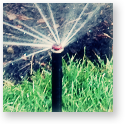Residential Sales
Installing a system
System Design is critical
When designing an irrigation system for residential or commercial use, numerous factors come into play. The dynamics involved are often intricate and detailed.
Here are some key aspects of developing a system:
1.
Information about the site.
Some of the considerations at a site include utility location, is there existing turf, sod or seed, where are sidewalks or driveways situated, and if there are other contractors present whose work might alter or change the existing landscape.
2.
The irrigation requirements.
Soil composition plays a large role in system design as this will determine how quickly the water is absorbed into the landscape. The percentage of turf, plants and trees will impact how much water is needed as will the amount of shade across the area to be irrigated.
3.
Available water and power supplies.
Is the water source from the local municipality or does the property draw off of a well? Attention needs to be given as to whether or not the water contains any rust or if the sulfur content is higher than usual. Power sources and locations need to be identified as well.
4.
Determining zones.
This is the process of dividing and grouping sprinkler heads and devices into efficient watering sections. As this is coming together it is important to take into account the following key points:
4.1
Selecting sprinklers and other equipment.
Different landscapes and terrain can require a variety of sprinkler heads and emitter tubing for drip irrigation. How and where to space the various sprinkler heads is essential to maintaining a good system. Rain sensors can help economize water use as well as solar sensors which determine the extent of sunlight exposure and how much water should be used in the weather conditions that are present.
4.2
The lateral layout; locating valves and main lines.
This is all about where to lay the pipes that deliver the water to the sprinklers, what main lines feed into the laterals, and circuiting the associated sprinklers into valve groups.
4.3
Types of controllers and where to locate them.
This involves determining whether or not to use a conventional or two-wire controller, or adding options such as a remote control. Locating the controller(s) is also important as it needs to be in a place that is accessible to a dependable electric source and convenient for the owner and users of the system.
Consider these factors:
These factors are just a snapshot of the components and planning necessary to design an effective irrigation system. Omissions and short cuts in any of these areas might reduce costs, but ultimately will have an adverse effect on how well your system operates and performs. Using a company who has had a stellar reputation of service and integrity for decades will be to the owner’s advantage in the long run.





